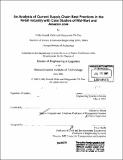An analysis of current supply chain best practices in the retail industry with case studies of Wal-Mart and Amazon.com
Author(s)
Chiles, Colby Ronald; Dau, Marguarette Thi
DownloadFull printable version (18.08Mb)
Other Contributors
Massachusetts Institute of Technology. Engineering Systems Division.
Advisor
Gabriel R. Bitran.
Terms of use
Metadata
Show full item recordAbstract
In support of the Supply Chain 2020 Project at MIT, this thesis identifies current best practices in retail industry supply chains, with a specific focus on mass merchandising and Internet retailing. Using a survey of current literature for context and industry expert interviews, this thesis assesses the current state of the retail industry and analyzes case studies of Wal-Mart and Amazon.com to illustrate retail supply chain best practices. Topics covered in each case study include supply chain strategy and business strategy linkage, operating models, supply chain design, replenishment and distribution processes, and ongoing supply chain improvement initiatives. Wal-Mart and Amazon.com are found to have very different supply chains in terms of structure and processes, based on their different operating models. However, there are many supply chain themes that are common among the two companies. Both case study companies have supply chain strategies, designs, and processes that clearly support their business strategies. Additionally, these companies tailor processes to fit specific product and demand profiles, collaborate extensively with supply chain partners, invest significantly in information technology, focus on operational efficiency, and leverage scale to facilitate competitive advantage through supply chain management. Based on the common and unique aspects of Wal- Mart and Amazon.com's supply chains, we provide recommendations for the potential transferability of Wal-Mart and Amazon.com practices within the retail industry and to other industries.
Description
Thesis (M. Eng. in Logistics)--Massachusetts Institute of Technology, Engineering Systems Division, 2005. Includes bibliographical references (leaves 184-188).
Date issued
2005Department
Massachusetts Institute of Technology. Engineering Systems DivisionPublisher
Massachusetts Institute of Technology
Keywords
Engineering Systems Division.